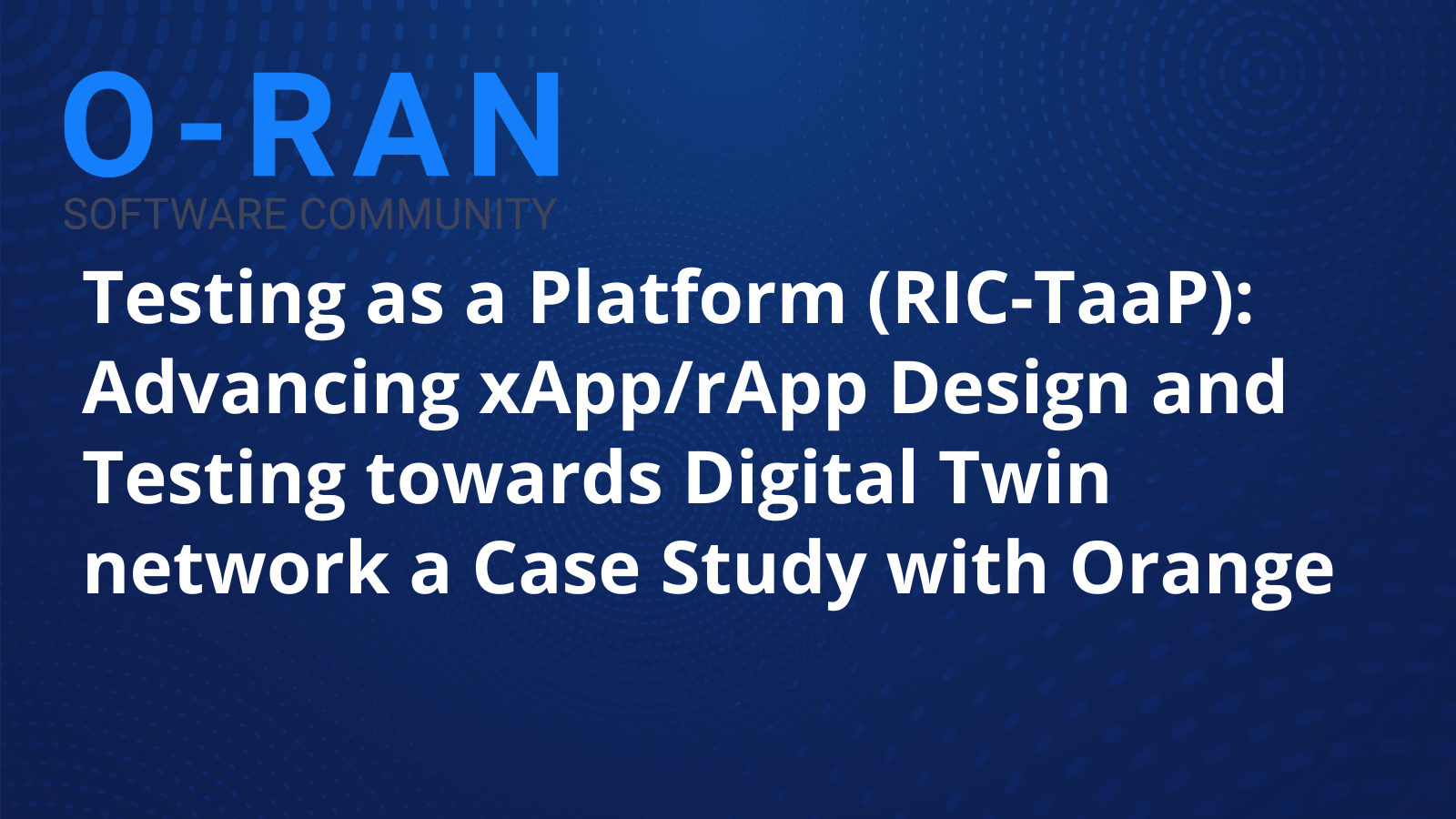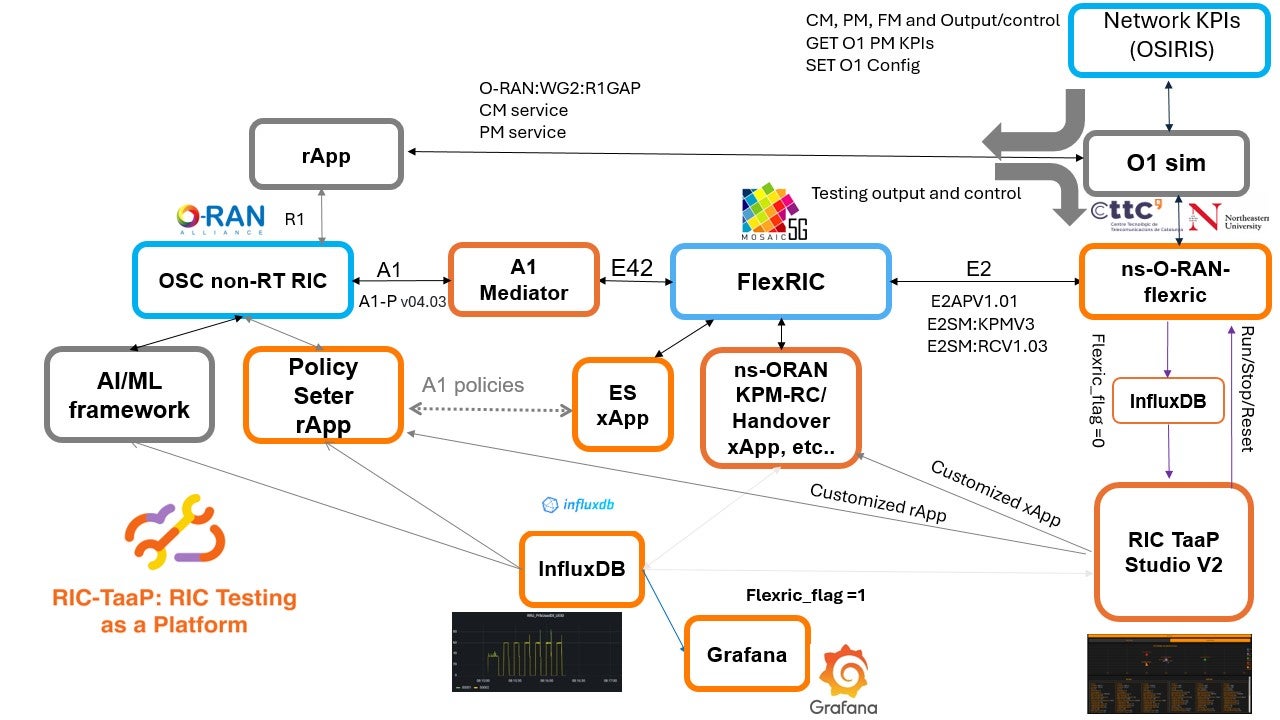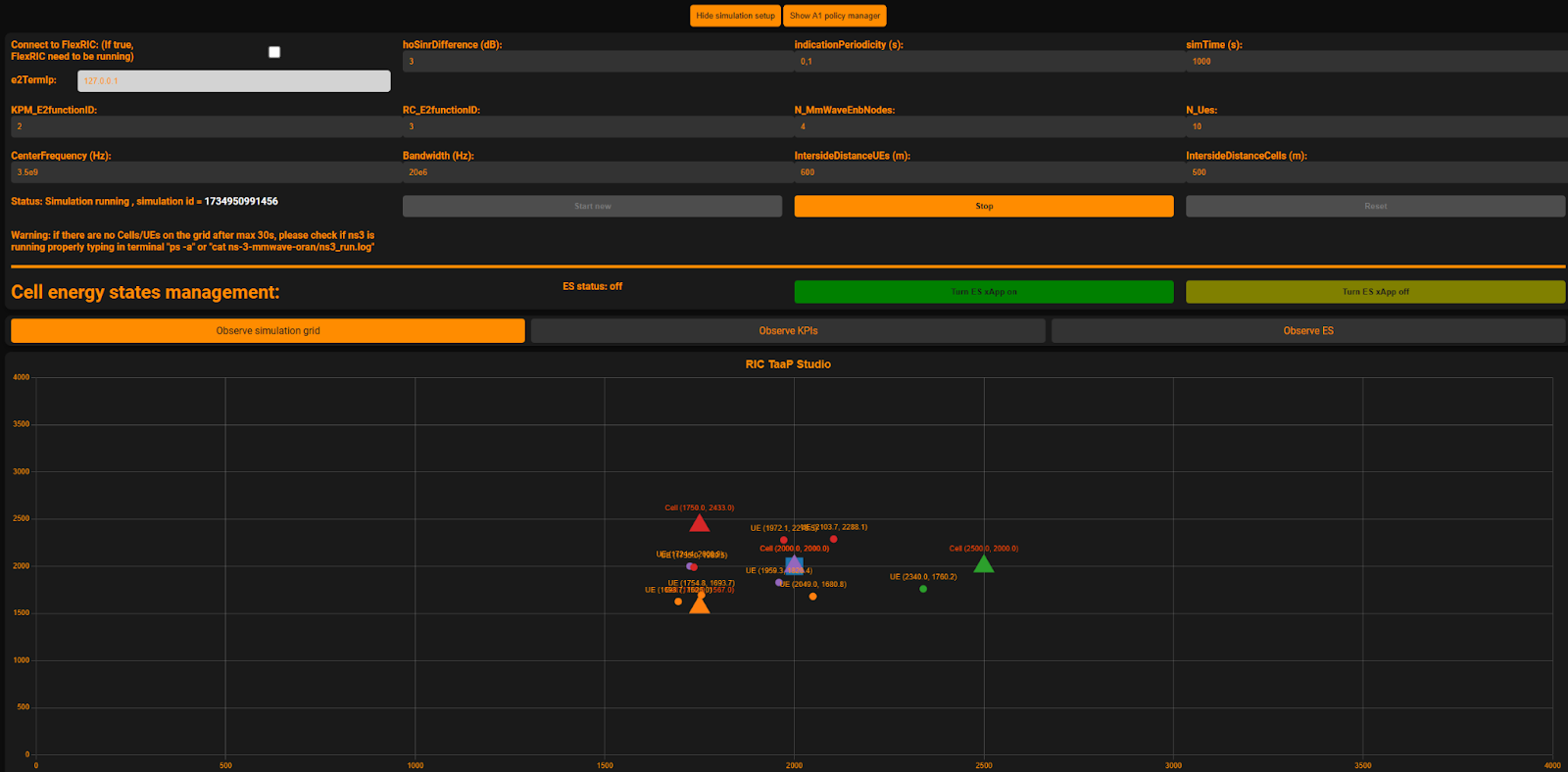
Author: Mina Yonan, Orange Innovation Egypt, mina.awadallah@orange.com
Problem
The adoption of the RAN Intelligent Controller (RIC) in networks encounters several challenges that may impede its objective and efficiency. To enable efficient and plug-and-play use cases, we can categorize these challenges into two key areas:
- Legacy SON Platform Limitations: The development and operational life-cycle of Self-Organizing Network (SON) modules is inherently slow due to the absence of a robust testing framework. The lack of a digital twin environment for network simulation and validation significantly hampers efficiency. Moreover, traditional SON platforms are not inherently designed to evolve with AI-driven methodologies, limiting their adaptability to dynamic network conditions and next-generation automation frameworks.
- High Barriers to Entry for xApp/rApp Ecosystem: A fundamental advantage of RIC is its ability to foster an open, interoperable ecosystem where third-party applications can be seamlessly integrated through standardized interfaces. However, the high costs associated with xApp/rApp testing and certification present a major hurdle for independent software vendors (ISVs), researchers, and academia. While RIC has expanded the ecosystem beyond traditional network equipment vendors to include a diverse set of stakeholders—such as Communication Service Providers (CSPs) and academic institutions—the financial and technical burdens of testing remain a key inhibitor to broader adoption and innovation.
Action
To address the aforementioned challenges, Orange has announced the development of RIC Testing as a Platform (RIC-TaaP)—an open source initiative designed to streamline xApp/rApp functional and operational testing, fostering innovation in xApp/rApp design and provide a proven digital-twin networks.
Recognizing the need for a robust, fully open source testing environment, Orange Innovation Egypt (OIE) has focused on enabling system-level use cases by leveraging advanced open source components. To achieve this, OIE has integrated FlexRIC from EURECOM with the ns-O-RAN simulator, originally developed by the Institute for the Wireless Internet of Things (WIoT) ,University of Padova and Mavenir. The team has enhanced the simulator to ensure full compliance with E2AP v1.01, KPM v3, and RC v1.03 standards, providing a sophisticated 5G simulation environment for validating complex use cases.
Additionally, Orange Innovation Poland (OIP) has augmented the platform with a user-friendly dashboard, RIC-TaaP Studio, enabling intuitive test scenario design and incorporating a range of operational features. Across its innovation centers, Orange continues to integrate leading open source solutions, including the 5G-LENA module, developed by the OpenSim Research Unit at the Centre Tecnològic de Telecomunicacions de Catalunya (CTTC).
Committed to openness and accessibility, Orange ensures that RIC-TaaP remains an open source and user-friendly platform, making Open RAN research and development more accessible to a broader community of engineers and researchers.
Key Components of RIC-TaaP

To establish a fully capable platform for xApp/rApp design and testing, RIC-TaaP comprises nine key components. These elements collectively form a flexible and robust network simulation environment, enabling efficient xApp/rApp development, validation, and deployment.
- FlexRIC – the implementation of the Near-RT RIC functionality, developed by EURECOM under the Mosaic5G project.
- NONRTRIC – Represents the Non-RT RIC functionality, developed by the O-RAN Software Community (OSC).
- ns-O-RAN Simulator – OIE introduces an enhanced version of the ns-O-RAN simulator, originally developed by the WIoT at Northeastern University. This upgraded version now supports standardized E2AP (11 messages) and service models, including KPMv3 and RCv1.03. Additionally, the E2 termination has been optimized for full compliance with FlexRIC E2 termination, ensuring seamless interoperability.
| E2APv1.01 | E2 SETUP REQUEST |
| E2 SETUP RESPONSE | |
| RIC SUBSCRIPTION REQUEST | |
| RIC SUBSCRIPTION RESPONSE | |
| RIC SUBSCRIPTION FAILURE | |
| RIC INDICATION | |
| RIC CONTROL REQUEST | |
| RIC CONTROL ACKNOWLEDGE | |
| RIC SUBSCRIPTION DELETE FAILURE | |
| RIC SUBSCRIPTION DELETE REQUEST | |
| RIC SUBSCRIPTION DELETE RESPONSE | |
| KPMv3 | List of KPIs supported by ns-O-RAN |
| RCv1.03 | – CONTROL Service Style 3 (Section 7.6) – Connected Mode Mobility Management (Section 7.6.4) – Control Action ID 1 (Handover Control) (Section 8.4.4.1) – Control Action ID 2 (Conditional Handover Control) (Section 8.4.4.2) – Control Action ID 3 (DAPS Handover Control) (Section 8.4.4.3) |
- 5G-LENA NR module: To extend the simulation capabilities, the team integrates the 5G-LENA module that covers the SU-MIMO and Enhanced PHY/MAC layer capabilities.
- A1 Mediator: OIP introduces a new version of OSC A1 mediator that can transfer A1 Policy Management (A1-P) into internal FlexRIC’xApps to smoothly transfer A1-P to xApp logic and operation.
- O1sim: Represents the O1 termination of the ns-O-RAN-FlexRIC platform, enabling Performance Measurement (PM) and Configuration Measurement (CM) in O1 NETCONF format. This ensures smooth integration of Service Management and Orchestration (SMO).
- OSIRIS: Moving towards a Digital Twin network, RIC-TaaP incorporates the OSIRIS tool, which enables vendor-specific KPI monitoring across different time frames. This tool—or any equivalent alternative—plays a key role in AI-driven rApp development, facilitating the exchange of control actions with twin networks via the ns-O-RAN-FlexRIC platform.
- RIC-TaaP Studio: RIC TaaP Studio allows users to run ns-3 simulations without needing a deep development background. It provides real-time monitoring of simulation status and key performance indicators (KPIs) for Cells and UEs, with more features planned for future releases. RIC TaaP Studio integrates a powerful combination of a graphical user interface (GUI), InfluxDB, and Grafana. The OIP team developed both the backend and frontend for the GUI and made enhancements to the ns-3 simulator to enable GUI interactions.

- xApp/rApp Examples: The team provide a E2E Energy Saving usecase that include:
- Control Actions: the team implemented the Mobility Management according RCv1.03 to initiate Hand Over (HO) commands.
- Reported KPIs: the team extends the reported KPIs from the ns-3 simulator to support a wide number of KPIs suitable for different xApp usecases.
- RIC-TaaP studio dashboards: The dashboard includes a new visualization tap for Energy Saving sub-usecase “cell/carrier switch ON/Off” in terms of the saving gain and performance KPIs to monitor the network before and after the xApp/rApp operation.
Results
Use-case 21: Energy Saving under Cell Utilization “Cell on/off” as an example
The Energy Saving (ES) logic example in RIC-TaaP is driven by cell utilization, particularly Physical Resource Block (PRB) usage (%). The decision-making process follows a structured sequence, as illustrated in the diagram below:
Sequence of Operations After xApp Execution
- xApp Requests KPM Report
- The xApp triggers a KPM Report (Style 4) request for UEs where PRB usage falls below the defined threshold.
- E2 Termination Processes KPM Report Request
- The E2 termination at ns-O-RAN-FlexRIC prepares the KPM report and subscription request for the relevant UEs.
- xApp Analyzes SINR Map
- The xApp evaluates the SINR map of surrounding cells to determine suitable candidates for handover.
- xApp Sends Handover (HO/CHO) Commands
- The xApp initiates a Connected Mobility procedure by sending Handover (HO) or Conditional Handover (CHO) commands using RIC CONTROL Style 3.
- ns-O-RAN-FlexRIC Executes Handover
- The handover is executed, and the E2 termination at ns-O-RAN-FlexRIC sends an acknowledgment to confirm the procedure.
- xApp Requests Updated KPM Report for SINR Map
- The xApp requests another KPM Report (Style 4) to obtain an updated SINR map post-handover.
- E2 Termination Generates Updated KPM Report
- The ns-O-RAN-FlexRIC prepares the requested KPM report based on the latest subscription request.
- xApp Analyzes UE SINR Post-Handover
- The xApp evaluates the new SINR values for UEs after mobility decisions.
- xApp Modifies Energy State
- Based on SINR and cell utilization, the xApp adjusts the Energy State of the Cell/Sector/Carrier to optimize power consumption.
- ns-O-RAN-FlexRIC Applies New Energy State
- The ns-O-RAN-FlexRIC enforces the new Energy State configuration as requested by the xApp.
The Energy Dashboard in RIC-TaaP Studio provides real-time monitoring of network performance and energy efficiency metrics. It includes three key categories:
1. QoS Parameters
- L3 SINR (dB): Displays the Signal-to-Interference-plus-Noise Ratio (SINR) for all UEs in the scenario, measured at Layer 3.
- PRB Usage (%): Indicates the Physical Resource Block (PRB) utilization for each cell in the scenario.
- Total Downlink Transport Block Errors (ErrTotalNbrDl): Represents the cumulative number of downlink transport block errors detected on the UE side.
2. Energy Consumption Metrics
- Energy Consumption (J): Measures the total energy consumption before and after xApp execution, allowing for comparative analysis of energy efficiency improvements.
- Average Power Consumption (W): Calculates the average power consumption across all cells in the scenario.
3. Energy State Mode
- Cell Power-Off Flag: Displays an indicator for each cell, signaling whether it has been switched off as part of energy-saving mechanisms.
Orange Team Leaders & Members
Domain Leader: Eric Hardouin, Orange Innovation, eric.hardouin@orange.com
Program Leader: Fabrice Guillemin, Orange Innovation, fabrice.guillemin@orange.com
Project Leader: Alassane Samba,Orange Innovation, alassane.samba@orange.com
Contributors
- Ayman Mostafa Hassan, Orange Innovation Egypt, ayman.hassan@orange.com
- Ahmed Elsanhoury, Orange Innovation Egypt, ahmed.elsanhoury@orange.com
- Mostafa Tawfeek,Orange Innovation Egypt, mustafa.tawfeek.ext@orange.com
- Mina Yonan, Orange Innovation Egypt, mina.awadallah@orange.com
- Mostafa Ashraf, Orange Innovation Egypt, mostafa.ashraf.ext@orange.com
- Kamil Kociszewski, Orange Innovation Poland, kamil.kociszewski@orange.com
- Adrian Oziębło, Orange Innovation Poland, adrian.ozieblo@orange.com
- Abdelrhman Soliman, Orange Innovation Egypt, abdelrhman.soliman.ext@orange.com
- Aya Kamal, Orange Innovation Egypt, aya.kamal.ext@orange.com